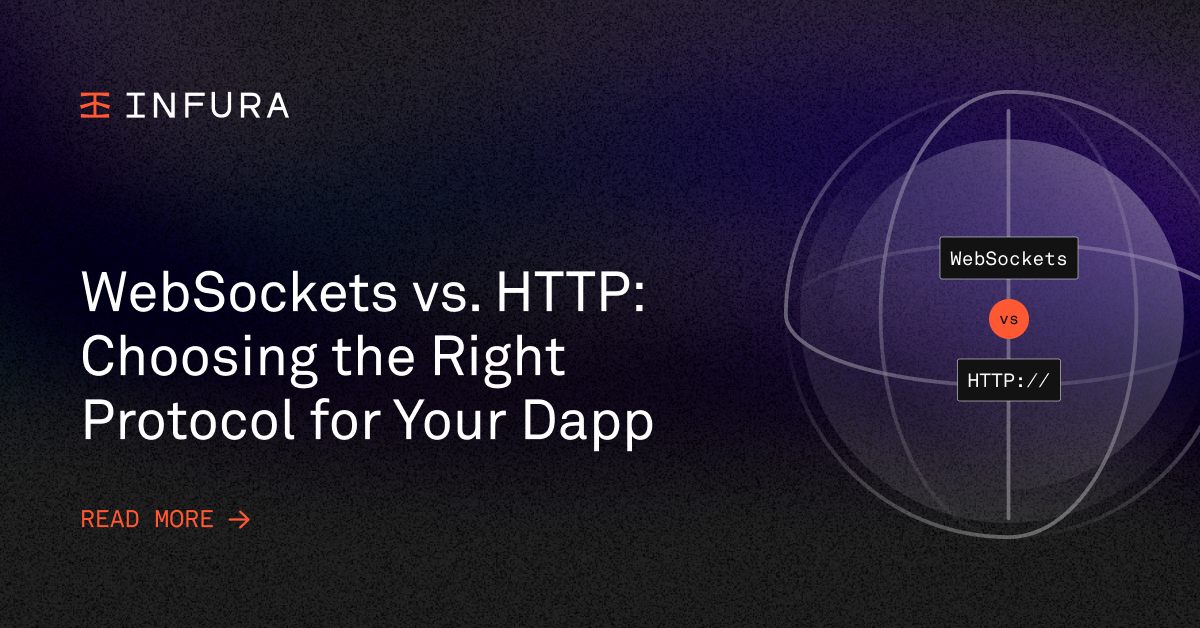WebSockets vs. HTTP: Choosing the Right Protocol for Your Dapp
Learn when to use WebSockets versus HTTP and the benefits of each for your next dapp.


Learn when to use WebSockets versus HTTP and the benefits of each for your next dapp.
Choosing the appropriate communication protocol for your dapp is a critical decision that can impact its performance and functionality. Important factors such as optimization, real-time updates, security, and compatibility should be carefully considered. By selecting the best protocol, you can ensure efficient and timely communication within your blockchain application.
WebSockets and HTTP (Hypertext Transfer Protocol) are two commonly used communication protocols for web applications. While WebSockets allow for two-way, persistent communication between a client (browser) and a server (blockchain network), HTTP follows a one-way, request-response paradigm that enables communication between a client and a server.
In this blog, we will delve into each protocols’ advantages, highlighting use cases where you would typically want to use one over the other. We’ll also explore how one can start using a WebSocket in blockchain applications with the Polygon WebSocket by Infura.
What is a WebSocket and when to use one
WebSocket is a communication protocol that enables real-time, bidirectional communication between a client and a server. It allows for instant updates and interactive communication, providing a seamless and responsive user experience for blockchain applications.
Unlike traditional HTTP, WebSocket establishes a persistent connection between a client and a server, allowing data to be sent and received in both directions simultaneously. It does this without the need for continuous polling.
Advantages of WebSocket over traditional HTTP
1. Real-time updates from the blockchain network: With WebSocket, you can add real-time updates to your application by allowing the server to push information to the client without needing constant requests. This can result in faster data transmission, ensuring timely updates and a more responsive user experience.
2. Bidirectional communication between your dapp and a blockchain network: WebSocket allows for simultaneous, two-way communication allowing both parties to send and receive data at any time, enabling interactive and dynamic applications that support real-time interaction and synchronization.
3. Lower latency and reduced overhead: WebSocket can reduce latency in an application by removing the need for repeated handshakes, thereby minimizing network overhead. This leads to faster communication, resulting in reduced delays and more responsiveness in an application.
When to use a WebSocket vs. HTTP
1. Blockchain analytics and monitoring: WebSocket is valuable for blockchain analytics platforms and monitoring tools. It allows for real-time data collection, analysis, and visualization, providing insights into blockchain network performance, transaction volumes, and other metrics.
2. Real-time chat applications: When building real-time chat applications where instant messaging and real-time updates are essential, WebSockets can be useful as It allows for instant message delivery, typing indicators, and presence information thus creating a seamless and interactive chat experience.
3. Gaming and multi-player applications: WebSocket is well-suited for multiplayer online games that require real-time interactions.
What is HTTP and when to use it
HTTP is a communication protocol that operates on a request-response principle, where the client sends a request to the server, and the server responds with the requested content and relevant status information.
HTTP enables the retrieval and transmission of various types of content, such as text, images, videos, and application data, over the Internet and supports various methods such as GET, POST, PUT, and DELETE.
Advantages of using HTTP over WebSockets
1. Simplicity and compatibility: HTTP is a widely adopted and well-documented protocol that is supported by all major clients. This widespread support and compatibility make it easier to implement and ensure broader accessibility across different systems and platforms.
2. Caching and proxies: HTTP benefits from extensive caching mechanisms and proxy server support. Caching allows content to be stored on intermediate servers, reducing the need for repeated data transmission and improving performance.
3. Stateless communication: HTTP is a stateless protocol, meaning each request is independent of previous requests. This can simplify server-side development, as servers don't need to maintain client state.
When to use HTTP vs. WebSockets
1. Retrieving static content: HTTP is well-suited for retrieving static content such as HTML files, CSS stylesheets, JavaScript files, and images. These resources typically don't require real-time updates or bidirectional communication, making the simplicity and compatibility of HTTP sufficient for delivering such content.
2. Non-real-time data exchange: If a blockchain application doesn't require instant updates or real-time communication, HTTP can be a suitable choice for example retrieving historical blockchain data, performing batch operations, or retrieving infrequently changing information may not require real-time capabilities provided by WebSocket.
Start using WebSockets in your dapp
Now that we know the difference between WebSocket and HTTP and when to opt for one over the other, let's explore how you can start leveraging the power of WebSockets in your next blockchain application.
Infura recently announced the expansion of its WebSocket offering to include the Polygon network, which means that developers who opt to build on Ethereum or Polygon can leverage Infura’s WebSocket offering for their next dapp. To learn more about Infura's WebSocket offering, you can refer to the official documentation.
If you're looking for a detailed, step-by-step tutorial on integrating Infura's WebSocket functionality into your blockchain application, we have prepared a comprehensive guide for you. Although it primarily focuses on the Polygon network, the same principles apply if you intend to build on the Ethereum network. The only difference is that, unlike Polygon, you don't need to activate an ADD ON for WebSocket on Ethereum—it's available for free.
